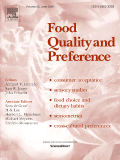New paper: How children approach a CATA test influences the outcome. Insights on ticking styles from two case studies with 6–9-year old children

Martina Galler (ESR1) recently published her first paper “How children approach a CATA test influences the outcome. Insights on ticking styles from two case studies with 6–9-year old children“ within EDULIA in “Food Quality and Preference”. A summary of the paper is given below, for the full paper please visit our publication page.
DOI: https://doi.org/10.1016/j.foodqual.2020.104009
Children vs. trained panel
For research but also new product development it can be of interest to study the sensory perception of children. Check-all-that-apply (CATA) is a particularly easy method for this scope. Sensory (and other) attributes that apply for the sample under evaluation are ticked rather than rated on an intensity scale as common in more elaborate descriptive methods. CATA studies with adults have shown comparable results to intensity rating based methods which require a trained panel.
In this paper we compared the results of two CATA case studies with 6-9-year old children to the sensory description by a trained profile panel with the following implications:
Children produced reliable sensory descriptions
The results of the two case studies indicated that children, age 6-9 years old, can describe sensory product differences. In both case studies children’s sensory descriptions with the CATA method were comparable to an intensity based descriptive analysis by a trained panel.
However, individual differences approaching the CATA test influenced the outcome
The analysis of children’s usage of the CATA list indicated different ticking style groups. Ticking style could, for example, serve as tool to determine participants that did not perform the task in a meaningful way based on their data.
Based on the two case studies recommendations for child-friendly CATA test protocols are provided
The two case studies had the aim to tailor the test setups to the cognitive level and interest of the 6 to 9 year old participants. A table with recommendations on how to set up a CATA test for children based on test observation and results can be found in the publication (in Table 6).
CATA, Children, ESR1, individual differences, sensory descriptive analysis. ticking style, WP3



